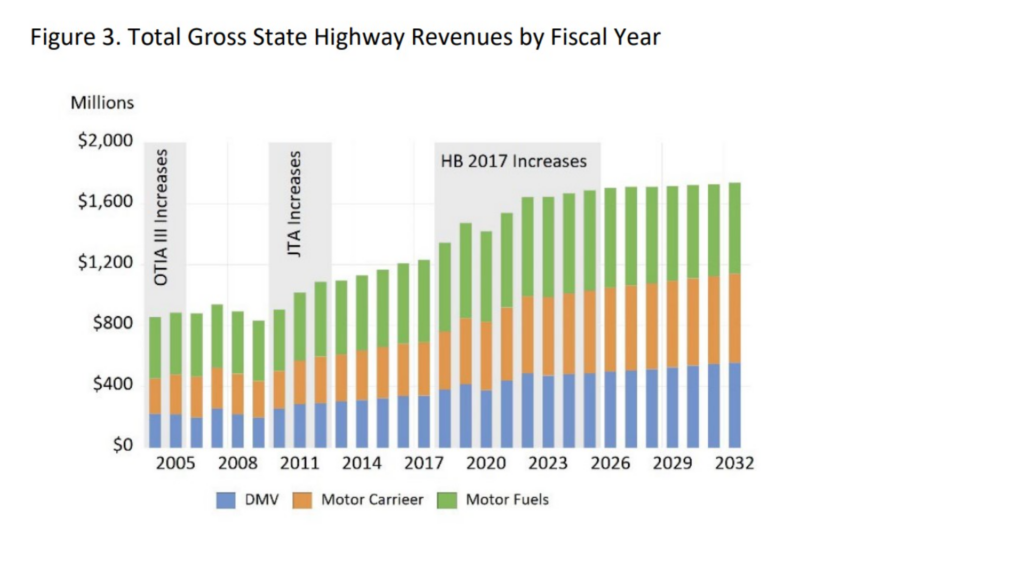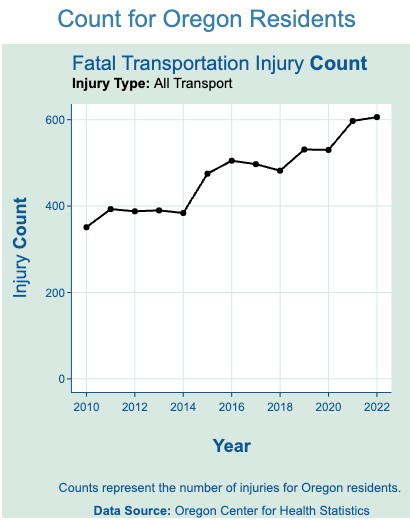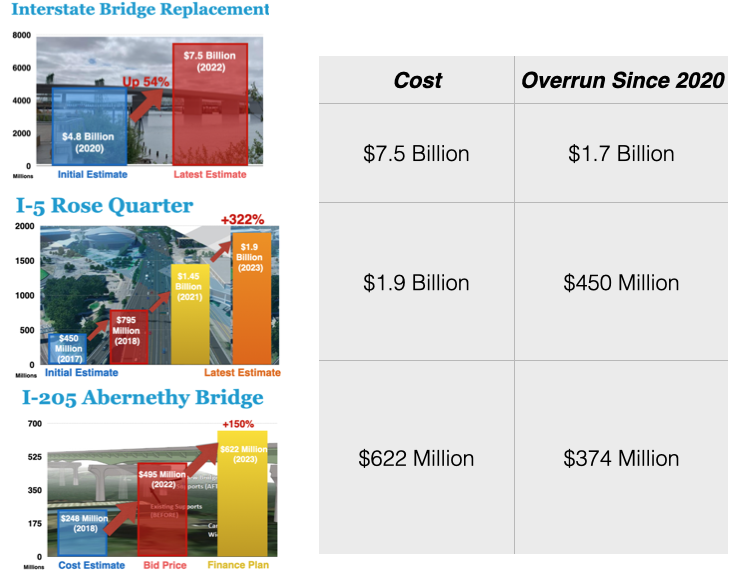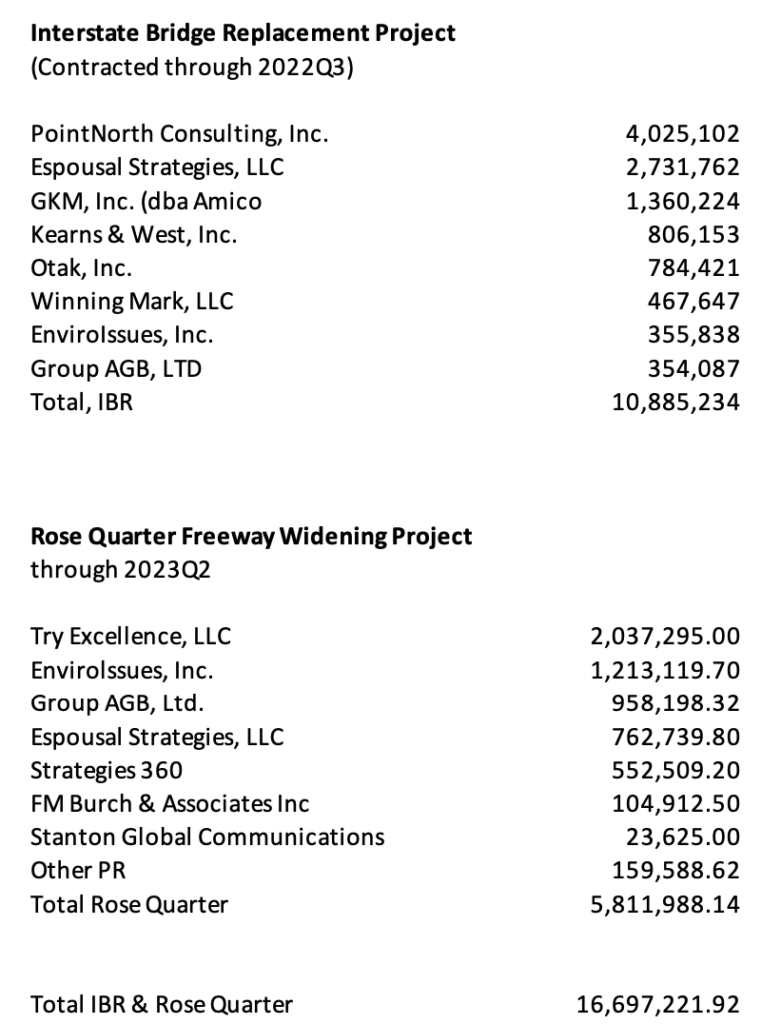Oregon’s Department of Transportation (ODOT) says it doesn’t have enough money to maintain roads, fix potholes or even plow snow.
This is a Big Lie: Mega-projects and their cost-overruns, not maintenance, are the cause of ODOT’s budget woes
ODOT has chosen to slash operations, while funneling hundreds of millions to billion-dollar-a-mile mega-projects and consultants
Plowing is a trivial part of the $3 billion ODOT budget; ODOT has voluntarily chosen to sacrifice plowing and other safety operations
ODOT’s gambit is a cynical and deadly version of the “Washington Monument” strategy: Give us money or we won’t plow your roads.
ODOT has aggravated this problem by repeatedly diverting operations and maintenance funds to road-widening projects
ODOT is choosing to make roads even more dangerous as Oregon road fatalities have increased 71 percent; it’s violating its own “Vision Zero” and “Safety First” policies.
The Snow Job: “Budget cuts are forcing us to reduce snow plowing“
Winter is nearly upon us, and the Oregon Department of Transportation has launched a new seasonal budget campaign, it’s claiming its too broke to plow state roads this winter, with the not-at-all-subtle message that people need to give ODOT more money. The agency’s PR machine has generated a raft of media stories uncritically repeating this story line:
ODOT says highways ‘may not be safe’ this winter due to budget cut
https://centraloregondaily.com/oregon-snowplows-reduced-winter-2023-gas-tax-revenue/
- Bend Bulletin, “Central Oregon Roads will look different this winter after ODOT reduces services“
- KTVZ (Bend) ODOT Sparks Central Oregon Concern over plan to reduce serivces this winter
- Central Oregon Daily, Expect less snowplowing of road to Mt. Bachelor, other roads, this winter.
- KPTV (Portland) ODOT says highways many not be safe this winer due to budget cuts.
- KATU (Portland) ODOT budget shortfalls will impact plowing, de-icing and salting.
- Bend Bulletin Highway near La Pine and Sunriver will get plowed less” ,
Fortunately, one media outlet didn’t fall for this contrived message. KGW-TV’s Pat Dorris has a long-form analysis that asks some basic questions and debunks
In October, the Oregon Department of Transportation began getting the word out that it will not have enough funding to plow or sand roadways over the coming winter to the extent that it has in previous years, blaming a combination of inflation and declining fuel tax revenue. But there is a distinction between the agency’s messaging and the facts. . . .
But the idea that fuel tax revenues have declined is not factually accurate. The Story looked at the numbers behind ODOT’s budget and could not verify that claim.
The Story’s Pat Dooris reached out to ODOT Director Kris Strickler to request an interview, but was told he was not available.
The Big Lie: Megaproject Cost-overruns, not maintenance are the cause of ODOT’s budget woes
ODOT has chosen to slash operations, while funneling hundreds of millions to megaprojects and consultants
The trouble is, as Dooris reported, the ODOT message is false: Snow removal (and other operations) are a minor, nearly trivial part of the ODOT budget, which instead is dominated by giant construction projects, which have been so badly mismanaged that they have cost-overruns running to billions of dollars. ODOT’s strategy is to threaten to slash snow plowing and other vital, and visible maintenance to build public pressure for greater funding. And in addition, ODOT’s budget is going up, not down: As KGW’s Pat Dorris has pointed out:
“it’s not accurate to say that fuel tax revenues have gone down — they are still going up”
As Dorris pointed out, the agency’s own revenue numbers show it has more money for the current fiscal year than previous fiscal years.
What this means is that ODOT is choosing to cut spending on operations and maintenance–and the reason it is doing that is because it is devoting huge sums to and handful of expensive highway projects in the Portland area. ODOT knows these projects aren’t popular, and it can’t defend its persistent cost overruns and expensive consultants, and so, instead, its threatening to cut vital and popular services like snowplowing, in order to gin up popular support for more funding.
It’s a cynical and deceptive ploy, one that endangers road users. ODOT is planning to reduce snow plowing on some roads, and not repaint fog lines on the sides of many rural highways. Cutting these modest expenditures won’t save much money, but what they will do is directly endanger road users.
ODOTs Budget Problems are from Squandering Billions on Megaprojects
To be absolutely clear: the problem with the ODOT budget is not a lack of funds to fix potholes and plow snow, but rather the exploding cost of highway widening megaprojects in the Portland Metropolitan Area. The maintenance “crisis” is purely a product of ODOT choices to slash funding for re-paving and regular operations, and instead dedicate hundreds of millions of dollars to a handful of expensive highway expansion projects–that are all experiencing dramatic cost-overruns.
- Item: The cumulative cost of three Portland mega-projects is nearly $10 billion. ODOT is prioritizing projects costing more than $1 billion per mile of roadway–the Rose Quarter is $1.9 billion for 1.5 miles; the I-5 Bridge is $7.5 billion for 5 miles, and the I-205 Abernethy Bridge, is $622 million for barely a half-mile.
- Item: Each of the three largest projects has experienced 100 percent or more cost-overruns. The cost increases announced in the past year amount to a total of more than $3 billion ($600 million increase for the Rose Quarter, $2.5 billion increase for the IBR, and $370 million increase for the I-205 Abernethy Bridge.
- Item: ODOT won’t even say how much will be saved by plowing less—it is at best a few million dollars, and will come mostly from laying off or not hiring ODOT front-line workers
- Item: ODOT’s says it needs to cut its overall budget by 5 percent, but ODOT has chosen to slash operations by four times as much: 20 percent, while holding harmless mega-project construction (in fact, funding continuing cost-overruns).
- Item: The Oregon Legislature gave ODOT $500 million in short-term borrowing authority in 2021. ODOT has used none of this authority to maintain operations. Instead, it has used all of this authority for highway widening projects–and the debt service on these short term bonds cuts in to revenue that could be used for operations.
- Item: The Highway Cost Allocation Study revealed that over the past several years, ODOT has systematically slashed spending for pavement preservation (repaving) and operations, and diverted more money to highway widening projects.
- Item: ODOT proposes to plow fewer roads, stop painting fog lines on many rural roads, and not fix as many potholes, just as the number of persons dying on Oregon roads has skyrocketed, with road deaths up 71 percent since 2010.
- Item: ODOT routinely juggles its books to “find” revenue for highway widening projects. It diverted $32 million in maintenance funds to Interstate Bridge Replacement project consultants and planning. It routinely finds “savings” and “unanticipated revenue” and uses them to launch expensive expansion projects, that experienced cost-overruns, instead of using those funds to maintain and fix existing roads.
- Item: ODOT proposes to spend $40 to 60 million over the next two years, largely on consultants, to advance the planning for the I-5 Rose Quarter project to the “30 percent” level of design—even though it lacks committed funds to pay for the full $1.9 billion project.
- Item: ODOT has spent more money on consultants for its highway widenings—over $100 million each for the I-5 Rose Quarter project and the Interstate Bridge Replacement project—than it will ever save by slashing snow plowing. ODOT has spent more than $16 million on public relations and communications consultants for these two projects (see below for details).
- Item: ODOT’s overall budget is more than $3 billion per year and was cut less than 2 percent from the previous biennium, yet the agency is cutting operations (like snow plowing) by ten times as much (20 percent).
In short, ODOT’s PR push to slash snow plowing is a cynical ploy to get Oregonians to give more money to an agency that has been reckless and irresponsible. The reason ODOT doesn’t have enough money for roads isn’t electric vehicle adoption or faltering revenues, its a spendthrift agency that’s chosen consultants and big contractors over the safety of road users and tax payers.
Plowing is a trivial part of the ODOT budget; ODOT has voluntarily chosen to sacrifice plowing and other safety operations
A close look at ODOT’s explanation shows a strong bias against basic safety operations. The agency has a $3 billion annual budget, and is seeing revenue increase—plus implementing a 2 cent a gallon gas tax increase in January. Yet it’s choosing to slash operations, like snow plowing ten times as much as its other parts of its operating budget–like administrative expenses.
While much of the agency is being asked to make a 5 percent reduction, ODOT has chosen to impose a four-fold higher reduction on basic operations, cutting them by 20 percent. In the agency’s regional “fact” sheets justifying the cuts, it says:
For our next budget, we implemented a 5% cut across all programs funded with state dollars. Within maintenance, we cut our services and materials an additional 15% to account for inflation and our reduced buying power.
ODOT’s region 4 report notes it cut its maintenance budget by 20 percent
Implementing our 2023-2025 budget For our next budget, we implemented a 5% cut across all programs funded with state dollars. Within maintenance, we cut our services and materials an additional 15% to account for inflation and our reduced buying power. We are reducing service in three primary areas:
• Low-volume road maintenance.
• Roadside maintenance.
• Winter maintenance
Despite its emphasis on cutting snow plowing, none of ODOT’s explanations show how much money the state will save by cutting these services. It’s not likely to be much. Overall, ODOT spends about $288 million on all “emergency services:–a broad category that includes everything from dealing with crashes, to plowing roads, to cleaning graffiti, and helping disabled motorists . A 20% cut in that mount is $56 million or about $29 million per year. $30 million per year is about one-tenth of one percent of ODOT’s annual spending.
Meanwhile, the agency is not imposing these same cuts on its plans for bloated freeway widening projects. Projects like the $7.5 billion dollar IBR, the $1.9 billion dollar Rose Quarter project, and the $622 million Abernethy Bridge projects–all of which have experienced 100 percent or more cost-overruns, are held harmless from ODOT’s proposed budget cuts. In fact, ODOT is doing just the opposite: promising to spend money it doesn’t have on these projects, and likely further cost overruns.
While ODOT has been mum about how much not plowing roads will save, it’s clear that its no a major amount of money in a $3 billion agency. How much does snow removal cost? The Pennsylvania highway department spends about $200 million per year on snow removal. The agency reports plowing, sanding and salting about 94,000 lane miles of highway, for a rough annual cost of $2,000 per lane mile, per year. The Klamath County road department reports spending about $1 million per year to plow about 100 miles of roadway in the county (about $5,000 lane mile per year). If ODOT were serious about its budget, it would tell us how much cutting back snow plowing will save–instead, they simply menace us with more dangerous roads, and ask for more money, which will mostly be used for highway widening.
Shorter ODOT: “Your money or your life.”
ODOT’s PR strategy boils down to: “Your money or your life.” We’ve squandered the gas tax increases you approved just six years ago on expensive boondoggle highway widening projects, and unless you give us more money, we’ll stop fixing potholes and plowing snow, and your roads will be more dangerous. And to be clear, plowing less comes at a cost in human life and limb. ODOT may not be adequately plowing roads to protect traveler safety. In 2021, a car plunged off the I-205 bridge, killing the vehicle’s driver; his family is suing ODOT for improperly plowing the bridge, creating a snow ramp that caused the vehicle to jump the guard rail.
ODOT’s plans to reduce plowing come after a decade in which statewide road deaths have spiked by 71 percent. In spite of the rising death toll, ODOT is choosing to slash its budget for basic safety operations, like plowing snow-covered roadways, and repainting fog lines on many roads. And ODOT admits its choice to slash plowing and other safety expenditures will likely injure and kill more Oregonians.
Glenn, the ODOT spokesperson, said the state transportation agency is troubled by the trend of increasing traffic deaths, both Oregon and nationwide.
But he said those findings won’t preclude major budget cuts that would eat into the agency’s operations and maintenance budget. The agency is facing a budget shortfall largely due to declining gas tax revenue and inflation.“We cannot commit that these service level reductions won’t impact safety,” Glenn wrote in an email. “However, we are working to prioritize safety for as many travelers as we can and data like this is helpful in that effort. We are working with our policymaking partners to identify solutions to this structural revenue issue so that we can better invest in building and maintaining a safe system for all users.”
ODOT diverts maintenance funds to highway expansion projects
ODOT routinely diverts funds allocated to and available for maintenance to fund capital construction projects. ODOT used interstate maintenance discretionary funds to pay for the planning of the failed Columbia River Crossing project. It diverted funds that could otherwise be used for maintenance to pay for the Interstate Bridge Replacement project. It routinely prioritizes capital construction in the use of “unanticipated federal funds” and “project savings.” It cobbled together just these funding sources to pay for the initial work on the I-205 Abernethy Bridge before the Legislature authorized any funding for the project. Each year it gets a tranche of what it calls “unexpected” federal funds (federal money that is unspent from nationally competitive programs that is allocated to the states). At its July, 2022 meeting ODOT recommended (and the OTC approved) using this money, which could be applied to the maintenance backlog, to fund $10 million towards the Interstate Bridge Replacement project.
In 2021, ODOT diverted $36 million in funds dedicated to maintenance to pay for consultants for the Interstate Bridge Replacement project. ODOT’s own memo makes this clear.
This project change requires adjustment to the fiscally constrained RTP. Funds from the fiscally constrained Fix-It buckets in the RTP will be reduced to allow for the $36M ODOT funds to be advanced on this project. Memo with details was sent to Metro 9/17/21 by Chris Ford. We find the analysis is still applicable with the addition of WDOT funds since RTP focuses on Oregon revenue only.
Chris Ford, Memo to Metro TPAC, “I-5:Columbia River (Interstate) Bridge: Requested Amendment to the 2021-24 Metropolitan Transportation Improvement Program.” Oregon Department of Transportation. September 24, 2021, aka ODOT/Ford Memo. Page 6. Emphasis added.
This is still going on today: At its November 9, 2023 meeting, the Oregon Transportation Commission is being asked to approve using $7.6 million in “savings” from a construction project to pay for further overruns on the I-205 bridge. If it wanted to the Commission could use these savings to pay for snow plowing—but it’s choosing not to.
ODOT excels at playing three-card monte with its budget, “finding” money for projects it wants to build, and while slashing spending on basic operations. In 2018, after the Legislature provided no funding for the I-205 Abernethy Bridge project, ODOT suddenly “found” tens of millions dollars in “savings”, “unanticipated revenues” and “unexpended funds” with which to launch the unfunded bridge project. Here’s a slide from ODOT’s December, 2018 briefing on the project:
Most of these funds (regional flexible funds, “reallocated savings,” “unanticipated federal revenue” and especially the “operation program funds,”) could all otherwise be used to pay for ODOT operations and maintenance—but instead they’re being used here to fund a capital construction project.
ODOT routinely pleads “pothole poverty” when asking for tax increases–then diverts the money to megaprojects
This is nothing new. Back when the Legislature was considering more funding for transportation in 2017, ODOT swore up and down it would use additional money to keep up roads, not build new ones. In 2017, ODOTs sales pitch for gas tax increases consisted of telling the public how much it cared about maintenance: Here’s the agency’s current deputy director, Travis Brouwer, speaking to OPB, in April, 2017 as the Legislature was considering a giant road finance bill.:
Of course, patching potholes are far from the only thing ODOT has to spend money on. So how does the agency decide what to prioritize? According to ODOT assistant director Travis Brouwer, basic maintenance and preservation are a top priority.“ Oregonians have invested billions of dollars in the transportation system over generations and we need to keep that system in good working order,” he said. “Generally, we prioritize the basic fixing the system above the expansion of that system.”
Back in 2017, the Oregon Department of Transportation put out a two-page “Fact Sheet” on the new transportation legislation. It’s first paragraph stressed that most of ODOT’s money would be for maintaining the existing system:
“Generally,” meaning, unless we decide to build shiny new projects—which they do. Make no mistake: When it comes to one of the agency’s pet mega-projects, there’s always money lying around, and if there isn’t, they’ll pretend like there is and charge full speed ahead, maxing out the credit cards to generate the cash.
A deadly take on the “Washington Monument” strategy
Budget wonks talk about a bureaucratic ploy known as the “Washington Monument Strategy.” Asked to cut their budget by a few percent, an agency chooses its most visible and valued service. The National Parks Service says if it its budget is cut, it will have to close the Washington monument (the nation’s most visited and visible national monument). The object is to rally public support for the agency’s budget, not to promote efficiency or focus on priorities. ODOT’s “we won’t plow” because of budget cuts is the same idea, with a lethal twist. Closing the Washington Monument doesn’t endanger tourists, it merely inconveniences them. Reducing plowing and not painting fog lines will likely lead to more crashes, injuries and deaths.
Mocking ODOT’s supposed “Safety First” and “Vision Zero” Policies
ODOT plans to slash these basic safety expenditures even as the state is experiencing increasing levels of traffic crashes, deaths and injuries. Just this month, the Oregon Health Division released a new dashboard showing the increasing death toll on the state’s roads and highways. Fatal injuries on Oregon roadways are up 71 percent since 2010, with more than 600 Oregonians killed.
The dashboard: Highway deaths up 71 percent since 2010
ODOT’s own stated goal is Zero fatalities and serious injuries–something it is utterly failing to do. The state’s Transportation Safety Action Plan says says the long term goal is for zero fatalities and serious injuries. The state’s target for 2022 was 444 deaths (TSAP, page 9); the actual number was over 600.
Oregon is committed to zero transportation-related fatalities and serious injuries. To make progress and improve traffic safety, stakeholders and partners are tasked with coordinating priorities, leveraging joint resources where possible, and using quantitative data-driven tools (e.g., benefit-cost analysis). Funds are limited; therefore projects, programs, and policies will need to be prioritized to focus on those treatments which will have the greatest benefit toward achieving the vision of zero fatalities and serious injuries. (TSAP, page 72, emphasis added)
ODOT’s own plans call for making safety a priority, even when there are tradeoffs with other objectives. It’s adopted Transportation Safety Action Plan calls for a quote “Safety First” prioritization.
For those who address transportation and/ or safety in their jobs, including the . . . ODOT,. . . cultural shifts will be seen when safety is prioritized as a core value. A strong safety culture means that agency leadership and employees, at all levels, are encouraged, and rewarded for prioritizing safety, and identifying safety issues and solutions while carrying out their agency’s missions and their individual job responsibilities.
TSAP, page 60.
ODOT’s decision to slash maintenance expenditures by 20 percent, while cutting its overall budget by 5 percent (and holding harmless a handful of megaprojects and consultant spending) flies in the face of its professed “Vision Zero” policies, and clear direction to prioritize safety first.
Megaprojects and ODOT Cost Overruns
ODOT is pursuing three massive highway expansion megaprojects in the Portland Metropolitan area wiht a total price tag of about $10 billion. Each of these projects costs more than $1 billion per mile of highway: The five-mile IBR is $7.5 billion (about 1.5 billion per mile), the one and a half mile Rose Quarter project is $1.9 billion (about $1.3 billion per mile) and the half-mile long I-205 Abernethy Bridge is $622 million (again, more than $1 billion per mile). Each of these projects has experiences enormous cost increases in the past three years, totalling more than $2.5 billion in increased costs. ODOT has shown no ability to accurately predict or control project costs, so further cost increases on all these projects are possible. These costs dwarf the cost of snow plowing and the revenue impacts of electric vehicles, yet ODOT says nothing about these expensive projects or their cost overruns in their explanation of their budget problems.
Prioritizing Funding for Consultants
These mega-projects involve hundreds of millions of dollars for consultants. OregonDOT and Washington DOT spent more than $200 million on the failed effort to plan the Columbia River Crossing (the failed earlier version of the IBR). Its already spent more than $100 million on the new IBR. Likewise, Oregon DOT has spent about $110 million on consultants and staff for the I-5 Rose Quarter Project.







